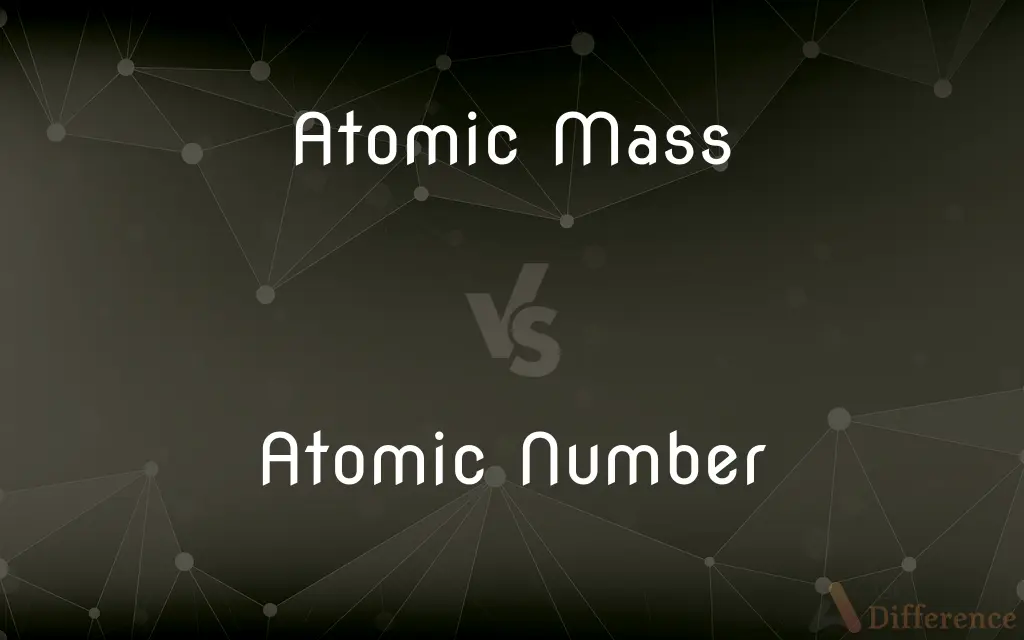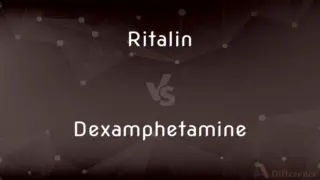Atomic Mass vs. Atomic Number — What's the Difference?
By Urooj Arif & Fiza Rafique — Published on March 7, 2024
Atomic mass measures an atom's total mass based on protons and neutrons, while atomic number is the count of protons in an atom's nucleus, defining its element.

Difference Between Atomic Mass and Atomic Number
Table of Contents
ADVERTISEMENT
Key Differences
The atomic number, denoted as Z, is a fundamental property of an atom that represents the number of protons in the nucleus. This number uniquely identifies a chemical element, as each element has a different number of protons. For example, hydrogen has an atomic number of 1, meaning it has one proton in its nucleus.
Atomic mass, also known as atomic weight, is a more complex measure that reflects the total mass of an atom. It is approximately equal to the sum of the number of protons and neutrons in the atom's nucleus since electrons contribute negligibly to an atom's mass.
The atomic number is always a whole number, while the atomic mass is often a decimal. This is because atomic mass takes into account the relative abundance of an element's isotopes—variations of an element with different numbers of neutrons—and their masses. For instance, the atomic mass of chlorine is about 35.5 because it naturally occurs as a mix of isotopes with mass numbers of 35 and 37.
Understanding the difference between atomic mass and atomic number is crucial in chemistry for identifying elements, understanding the periodic table, and predicting elements' chemical behavior. The atomic number determines an element's position on the periodic table, while the atomic mass is important for calculating the masses of molecules and moles of material in chemical reactions.
Comparison Chart
Definition
Number of protons in an atom's nucleus
Approximate total mass of protons and neutrons
ADVERTISEMENT
Unit
None (pure number)
Atomic mass units (amu)
Nature
Always a whole number
Often a decimal value
Variation
Unique for each element
Varies with isotopes
Role in Chemistry
Identifies the element
Important for calculating molecular masses
Compare with Definitions
Atomic Mass
Measured in atomic mass units.
The atomic mass of hydrogen is approximately 1.008 amu.
Atomic Number
Is unique for each element.
No two elements share the atomic number 7.
Atomic Mass
Includes protons and neutrons in the calculation.
An iron atom with 26 protons and 30 neutrons has an atomic mass around 56 amu.
Atomic Number
Determines the chemical element of an atom.
Carbon’s atomic number 6 identifies it as carbon.
Atomic Mass
Essential for stoichiometry in chemistry.
Calculating the mass of CO2 produced in a reaction requires the atomic masses of C and O.
Atomic Number
Defines the element's position on the periodic table.
Helium’s atomic number 2 places it at the top of the noble gases.
Atomic Mass
Affected by the relative abundance of isotopes.
Carbon’s atomic mass is 12.01 due to the presence of C12 and C13.
Atomic Number
The count of protons in an atom.
Oxygen has an atomic number of 8.
Atomic Mass
The weighted average mass of an atom's isotopes.
Boron has an atomic mass of about 10.81 amu.
Atomic Number
Unchanged by isotopes.
All isotopes of nitrogen have an atomic number of 7.
Common Curiosities
How does the atomic number influence the chemical behavior of an element?
The atomic number determines the number of electrons in a neutral atom, which in turn dictates the atom’s reactivity and placement in the periodic table.
Can atomic number change in a chemical reaction?
No, chemical reactions involve the rearrangement of electrons and do not change the atomic number.
Do isotopes affect the atomic number?
Isotopes do not affect the atomic number; they have the same number of protons but differ in the number of neutrons.
How is atomic mass useful in everyday life?
Atomic mass is used in calculating nutritional information, dosages for medications, and in industries like petrochemicals for process calculations.
Why is atomic mass not a whole number?
Atomic mass is often not a whole number because it is a weighted average of all naturally occurring isotopes of an element.
What determines the atomic mass of an element?
The atomic mass is determined by the mass and relative abundance of each isotope of the element.
How do scientists measure atomic mass?
Atomic mass is measured using mass spectrometry, which separates isotopes based on mass and charge, allowing precise measurements.
Why are atomic number and atomic mass important in chemistry?
They identify elements, determine their properties, and are crucial for calculating molecular masses and compositions in reactions.
What is the significance of the difference in atomic mass among isotopes?
The difference in atomic mass among isotopes affects the atomic mass of the element and can influence physical properties like density.
Can the atomic mass of an element change over time?
The reported atomic mass of an element can vary slightly with new measurements of isotope abundances, but significant changes are rare.
Why might the atomic mass on the periodic table not match the sum of protons and neutrons?
The atomic mass accounts for isotope distributions and the binding energy of the nucleus, leading to slight differences from a simple sum.
How do atomic number and atomic mass relate to an element’s identity and stability?
The atomic number defines the element’s identity, while the atomic mass can indicate stability variations among its isotopes.
Can an element's atomic number be zero?
No, the atomic number starts at 1 (hydrogen) and increases from there, as it represents the number of protons.
Is it possible for two elements to have the same atomic mass?
While theoretically possible due to rounding, in practice, each element has a unique atomic mass due to its isotopic composition.
What role does the atomic number play in the periodic table?
The atomic number determines an element’s position in the periodic table, organizing elements by their chemical properties.
Share Your Discovery

Previous Comparison
Baptists vs. Christians
Next Comparison
Santeria vs. VoodooAuthor Spotlight
Written by
Urooj ArifUrooj is a skilled content writer at Ask Difference, known for her exceptional ability to simplify complex topics into engaging and informative content. With a passion for research and a flair for clear, concise writing, she consistently delivers articles that resonate with our diverse audience.
Co-written by
Fiza RafiqueFiza Rafique is a skilled content writer at AskDifference.com, where she meticulously refines and enhances written pieces. Drawing from her vast editorial expertise, Fiza ensures clarity, accuracy, and precision in every article. Passionate about language, she continually seeks to elevate the quality of content for readers worldwide.













































